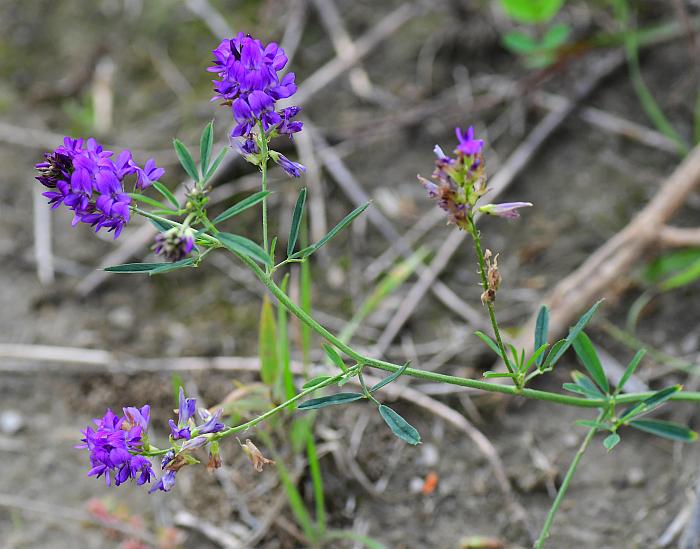Medicago sativa L.
Alfalfa

Introduced
CC = *
CW = 5
MOC = 51
© SRTurner
Medicago sativa L.Alfalfa | |
 |
Introduced CC = * CW = 5 MOC = 51 |
© SRTurner |
|
Family - Fabaceae/Faboideae Habit - Long-lived perennial forb with deep taproots below a knobby or sometimes short-branched, woody caudex. Stems - Loosely ascending to erect, to 60 cm, sometimes from a spreading base, sometimes multiple from base, branching, sometimes clump-forming, glabrous or finely hairy.
Leaves - Alternate, trifoliate, petiolate, stipulate. Petioles mostly 10-50 mm long, those of the uppermost leaves sometimes shorter. Stipules 6-18 mm long, the margins entire or shallowly toothed toward the base, fused to the petiole toward the base. Leaflets 10-32 mm long, 2-12 mm wide, oblanceolate to elliptic or narrowly obovate, toothed to entire, rounded to minutely notched at the tip, the midvein often extended as a short, narrowly triangular, sharply pointed tooth at the very tip, the surfaces glabrous or sparsely hairy.
Inflorescence - Dense, compact racemes, appearing as headlike clusters, more or less globose to oblong-ovoid or short-cylindric at flowering, with 10-30 flowers, often extending beyond the subtending leaves, the stalk 10-30 mm long, typically pubescent.
Flowers - Calyces with the tube 1.5-2.0 mm long, the lobes 2.5-3.5 mm long. Corollas papilionaceous, 6-11 mm long, blue to purple, rarely yellow. Stamens 10, all of similar length, diadelphous. Filaments with the fused portion 4-5 mm long, the free portion 1-2 mm long.
Fruits - Modified legumes 4-6 mm long, longer than wide, strongly curved to loosely coiled 1-3 turns, smooth, not prickly, glabrous or finely hairy, yellow to brown, 3-8-seeded. Flowering - May - September. Habitat - Streambanks, marshes, bluff tops, pastures, fields, levees, railroads, roadsides, open, disturbed areas. Also cultivated. Origin - Native to Eurasia. Lookalikes - Broadly, species of Vicia. Other info. - M. sativa occurs across Missouri and the entire continental U.S., mostly as a cultivated crop. It is perhaps the oldest and most important crop for livestock forage, cultivated long before recorded history. It is nutritious, robust, and drought resistant. Though the plant sometimes escapes cultivation, it is not particularly weedy and rarely invades natural areas. When flowering the plant is easily recognized, being the only Medicago in Missouri with purple flowers. The trifoliate leaves easily distinguish it from other purple-flowered legumes such as the vetches (Vicia spp.). The relatively large stipules are another aid to identification. Photographs taken somewhere in North Carolina, 5-16-03 (DETenaglia); also near Creve Coeur Park, St. Louis County, MO, 10-24-2021 (SRTurner). |